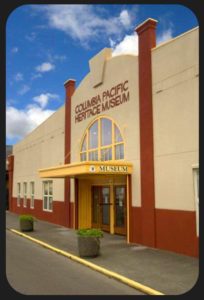The story of transportation on the peninsula began when Lewis Loomis and investors built a wharf in Ilwaco in 1874. A stage line connected passengers, goods and mail between Oysterville and Ilwaco. To connect with the outside world, Loomis and fellow incorporators created the Ilwaco Steam Navigation Co., and purchased the steamship GENERAL CANBY in 1875.
The Ilwaco Railway and Navigation Co. (IR&N) was built in 1888-1889, and operated under that name until 1907. When the railroad began operations in 1888, steamer connections were already in place, but the increase in commerce begged for improvement. In 1891, Jacob Kamm was commissioned to build a steamer to run directly between Ilwaco and Portland on the Willamette River. The OCEAN WAVE began service in September. The IR&N ran north to the port of Nahcotta where it met the steamships SHAMROCK and RELIABLE for connections to South Bend on Willapa Bay, and its connection to the Northern Pacific Railroad.
In 1891, the US Lifesaving Service established a station, known as Ilwaco Beach, mid-way between stations at Cape Disappointment and North Cove. The site was in an area of many shipwrecks. It was also adjacent to the rail line. Because the tracks ran close to the ocean north of Long Beach to Ocean Park, for a fee of $15.00, the railroad provided flat cars to move lifeboats and crews to wrecks that were miles from the Station. During the summer, excursion trains brought people to watch the rescue drills at the Ilwaco Beach (Klipsan Beach) Lifesaving Station.
August of 1900 saw a change as Loomis sold the IR&N to the Oregon Railway and Navigation Co. (OR&N). The railroad continued to operate under the IR&N name. With the new ownership, the side-wheel steamer T. J. POTTER began service from Portland to Ilwaco. In 1905, new superintendent Edward R. Budd is credited with the comment: “Clamshell Railroad”.
The “Clamshell Railroad” not only carried passengers, but they also carried a substantial amount of freight. Trains also carried, milk, oysters, coal, cranberries, and finished lumber as well as packaged goods for the merchants on the Peninsula. Much of this freight was carried in box cars added to one of the regularly scheduled passenger trains making it a “mixed train” but occasionally an “extra” freight train would be added on the line. This might be true for a shipment of logs, or for the transport of cranberries at harvest time. Also, a caboose to carry crew members was at the tail end of the freight trains.
In 1907, the OR&N reorganized the IR&N as the Ilwaco Railroad Co. It operated under that name until 1910, when the Union Pacific Railroad, which now owned all of the OR&N stock, consolidated the OR&N along with other owned entities into a single subsidiary, the Oregon-Washington Railroad and Navigation Co. (O-WR&N). For about five years until 1915, it operated as the O-WR&N. In 1915, the O-WR&N renumbered and added the Union Pacific logo on all of its equipment. In 1921, auto ferry service began between Astoria and McGowan. Later, the ferries would use Megler as a terminus with the railroad sharing that area until the railroad ceased operation in Sept 1930.
“Clamshell Railroad” has become a term of endearment that incorporates all of these entities from 1888 until 1930.
